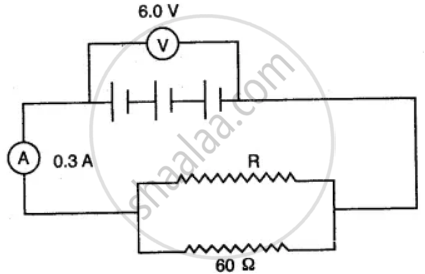Advertisements
Advertisements
प्रश्न
Show how would you connect three resistors, each of resistance 6 O so that
the combination has a resistance of(a) 9 Ω (b) 4 .Ω
उत्तर
(a) To get an equivalent resistance of 9Ω using three 6 Ω resistors, they should be connected in parallel as shown:

Between A and C, the equivalent resistance is
`1/"R"_"parallel" = 1/6 + 1/6 = 2/6 = 1/3 Ω`
`"R"_"parallel" = 3 Ω
Between A and B, the equivalent resistance is
`"R"_"series" = 3 + 6 = 9Ω
(b) To get an equivalent resistance of 4 Ω using three 6 Ω resistors, they should be connected in parallel as shown:

Between A and B, the series combination of two 6 Ω resistors is connected in parallel with the third 6Ω resistor.
`"R"_"series" = 6 + 6 = 12Ω`
`1/"R"_"equivalent" = 1/6 + 1/12 = 3/12 = 1/4 Ω`
APPEARS IN
संबंधित प्रश्न
You are given three resistances of 1, 2 and 3 ohms. Shows by diagrams, how with the help of these resistances you can get:
(i) 6 Ω
(ii) `6/1` Ω
(iii) 1.5 Ω
How will you connect three resistors of resistances 2 Ω, 3 Ω, and 6 Ω to obtain a total resistance of 4 Ω, and 1 Ω?
A combination consists of three resistors in series. Four similar sets are connected in parallel. If the resistance of each resistor is 2 ohm, find the resistance of the combination.
Explain, why is the p.d. between the terminals of a storage battery less when it is supplying current than when it is on open circuit. A battery of e.m.f. 10 volts and internal resistance 2.5 ohms has two resistances of 50 ohms each connected to it. Calculate the power dissipated in each resistance
(a) When they are in series,
(b) When they are in parallel.
In each case calculate the power dissipated in the battery.
A particular resistance wire has a resistance of 3 ohm per meter. Find :
The total resistance of three lengths of this wire each 1.5 m long, in parallel.
How does the resistance of a metallic wire depend on the thickness of wire?
In the figure below, the ammeter A reads 0.3 A. Calculate:
(i) the total resistance of the circuit
(ii) the value of R
(iii) the current flowing through R.

What connection is used in domestic appliances and why?
A piece of wire having a resistance R is cut into five equal parts.
- How will the resistance of each part of the wire change compared with the original resistance?
- If the five parts of the wire are placed in parallel, how will the resistance of the combination change?
- What will be ratio of the effective resistance in series connection to that of the parallel connection?
Four resistors each of resistance 5 Ω are connected in parallel. What is the effective resistance?
